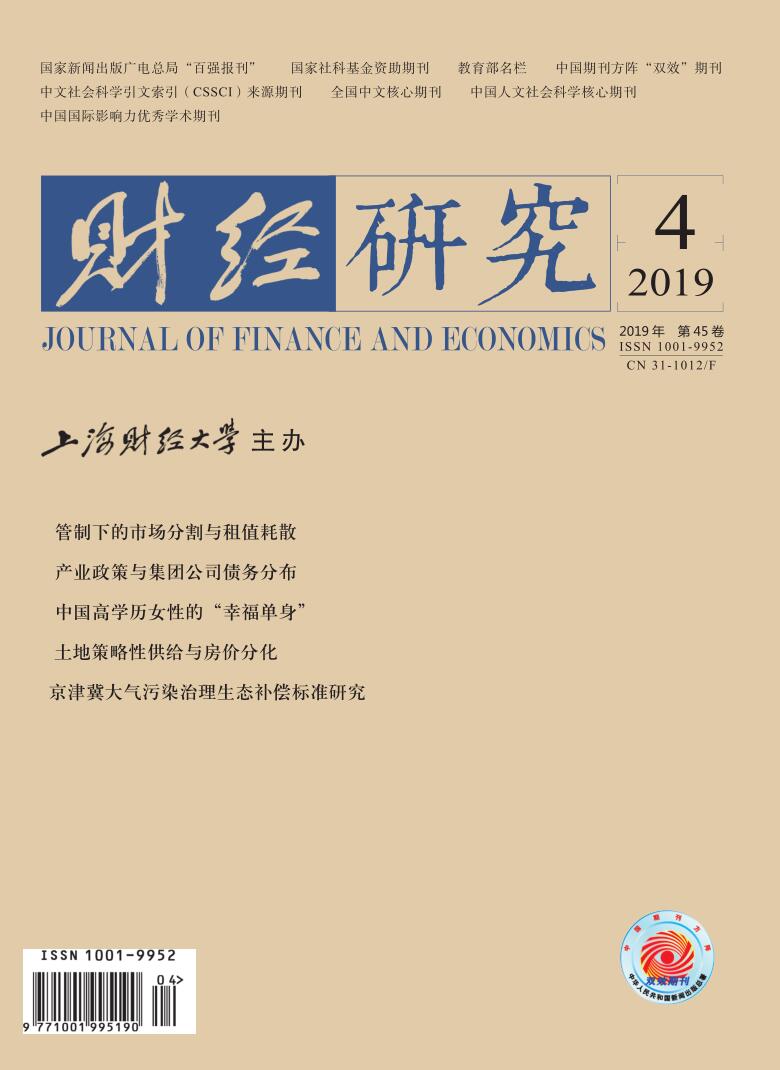文章根据2010−2014年CFPS的调查数据,深入分析了中国家庭消费平滑的区域差异及其根源。首先,基于风险分担模型,选取合适的代理变量测度了东部、中部和西部地区以及城乡家庭消费平滑的能力;其次,运用Oaxaca-Blinder分解法从家庭、社区和政府三个层面去寻找导致消费平滑的根源。研究结果发现:东部地区家庭的消费平滑能力最强,中部次之,西部最弱,并且城镇家庭的消费平滑能力也要强于农村家庭。消费平滑区域差异的主要根源来自家庭自给与国家政策层面,尤以家庭净财产和政府补助的作用最为突出。这也反映了政府没能成功利用转移支付等方式去进行有效的收入再分配,从而达到缩小区域间消费平滑差异的目的。而社区层面上的家庭社会交往,则对缩小地区间消费平滑能力差距起了显著作用。其他一些因素如户主学历、家庭规模和区域金融比率等也影响着平滑能力的大小。各地区政府需要针对上述深层次的原因,有的放矢地采取措施方能提升当地的消费潜力。
我国消费平滑的地区性差异及其根源:家庭、社区和政府的比较分析
摘要
参考文献
4 邓曲恒. 农村家庭的消费平滑:对完全保险假说的检验[J]. 浙江学刊,2012,(5):163−173 DOI:10.3969/j.issn.1003-420X.2012.05.025
6 郭新华,李卓宇. 劳动供给对消费平滑的影响——基于RUMiC数据的微观实证[J]. 湘潭大学学报(哲学社会科学版),2017,41(1):72−79 DOI:10.3969/j.issn.1001-5981.2017.01.013
8 寇恩惠,侯和宏. 消费平滑、收入波动和局部保险−基于农村居民数据的分析[J]. 财贸经济,2015,(9):33−45 DOI:10.3969/j.issn.1005-913X.2015.09.019
10 陆铭,张爽,佐藤宏. 市场化进程中社会资本还能够充当保险机制吗?−中国农村家庭灾后消费的经验研究[J]. 世界经济文汇,2010,(1):16−38 DOI:10.3969/j.issn.0488-6364.2010.01.002
17 Ambrus A,Mobius M,Szeidl A. Consumption risk-sharing in social networks[J]. The American Economic Review,2014,104(1): 149−182. DOI:10.1257/aer.104.1.149
18 Angelucci M,De Giorgi G,Rangel M A,et al. Family networks and school enrolment:Evidence from a randomized social experiment[J]. Journal of Public Economics,2010,94(3-4): 197−221. DOI:10.1016/j.jpubeco.2009.12.002
19 Attanasio O, Meghir C, Mommaerts C. Insurance in extended family networks[R]. NBER Working Paper No. 21059, 2015.
20 Attanasio O,Meghir C,Santiago A. Education choices in Mexico:Using a structural model and a randomized experiment to evaluate Progresa[J]. The Review of Economic Studies,2012,79(1): 37−66. DOI:10.1093/restud/rdr015
21 Bayoumi T. Explaining consumption:A simple test of alternative hypotheses[J]. Staff Papers-International Monetary Fund,1997,44(4): 462−484. DOI:10.2307/3867462
23 Blundell R,Pistaferri L,Preston I. Consumption inequality and partial insurance[J]. American Economic Review,2008,98(5): 1887−1921. DOI:10.1257/aer.98.5.1887
24 Blundell R,Pistaferri L,Saporta-EkstenI. Consumption inequality and family labor supply[J]. American Economic Review,2016,106(2): 387−435. DOI:10.1257/aer.20121549
25 Blundell R, Pistaferri L, Saporta-Eksten I. Children, time allocation and consumption insurance[R]. NBER Working Paper No. 24006, 2017.
26 Bramoullé Y,Kranton R. Public goods in networks[J]. Journal of Economic Theory,2007,135(1): 478−494. DOI:10.1016/j.jet.2006.06.006
27 Bronchetti E T. Workers’ compensation and consumption smoothing[J]. Journal of Public Economics,2012,96(5-6): 495−508. DOI:10.1016/j.jpubeco.2011.12.005
28 Chetty R,Looney A. Consumption smoothing and the welfare consequences of social insurance in developing economies[J]. Journal of Public Economics,2006,90(12): 2351−2356. DOI:10.1016/j.jpubeco.2006.07.002
29 Colmer J, Alem Y. Consumption smoothing and the welfare cost of uncertainty[R]. Centre for Climate Change Economics and Policy Working Paper No. 138, 2015.
30 Deaton A. On risk, insurance, and intra-village consumption smoothing[C]. Research Program in Development Studies, Working Paper, 1990.
32 Fafchamps M,Lund S. Risk-sharing networks in rural Philippines[J]. Journal of Development Economics,2003,71(2): 261−287. DOI:10.1016/S0304-3878(03)00029-4
35 Gruber J. Cash welfare as a consumption smoothing mechanism for divorced mothers[J]. Journal of Public Economics,2000,75(2): 157−182. DOI:10.1016/S0047-2727(99)00080-8
36 Gul F,Pesendorfer W. Self-control and the theory of consumption[J]. Econometrica,2004,72(1): 119−158. DOI:10.1111/ecta.2004.72.issue-1
37 Jann B. A Stata implementation of the Blinder-Oaxaca decomposition[R]. Eth Zurich Sociology Working Papers No. 8, 2008.
38 Kaplan G,Violante G L. A model of the consumption response to fiscal stimulus payments[J]. Econometrica,2014,82(4): 1199−1239. DOI:10.3982/ECTA10528
39 Kochar A. Smoothing consumption by smoothing income:Hours-of-work responses to idiosyncratic agricultural shocks in rural India[J]. Review of Economics and Statistics,1999,81(1): 50−61. DOI:10.1162/003465399767923818
40 L’Huillier J P, Piguillem F, Flemming J. The optimal tradeoff between consumption smoothing and macroprudential regulation[R]. Meeting Papers 492, Society for Economic Dynamics, 2015.
41 Ljungqvist L,Uhlig H. Tax policy and aggregate demand management under catching up with the joneses[J]. American Economic Review,2000,90(3): 356−366. DOI:10.1257/aer.90.3.356
42 Meng X. Unemployment,consumption smoothing,and precautionary saving in urban China[J]. Journal of Comparative Economics,2003,31(3): 465−485. DOI:10.1016/S0147-5967(03)00069-6
43 Modigliani F, Brumberg R. Utility analysis and the consumption function: An interpretation of cross-section data[A].Kurihara K. Post Keynesian economics[C]. New Brunswick: Rutgers University Press, 1954.
44 Townsend R M. Risk and insurance in village India[J]. Econometrica,1994,62(3): 539−591. DOI:10.2307/2951659
46 Zheng Y, Santaeulalia-Llopis R. Partial insurance and aggregate welfare in China: 1989 to 2009[R]. Meeting Papers 1389, Society for Economic Dynamics, 2014.
引用本文
李立, 李春琦. 我国消费平滑的地区性差异及其根源:家庭、社区和政府的比较分析[J]. 财经研究, 2019, 45(4): 124-139.
导出参考文献,格式为:





 8200
8200  11177
11177

